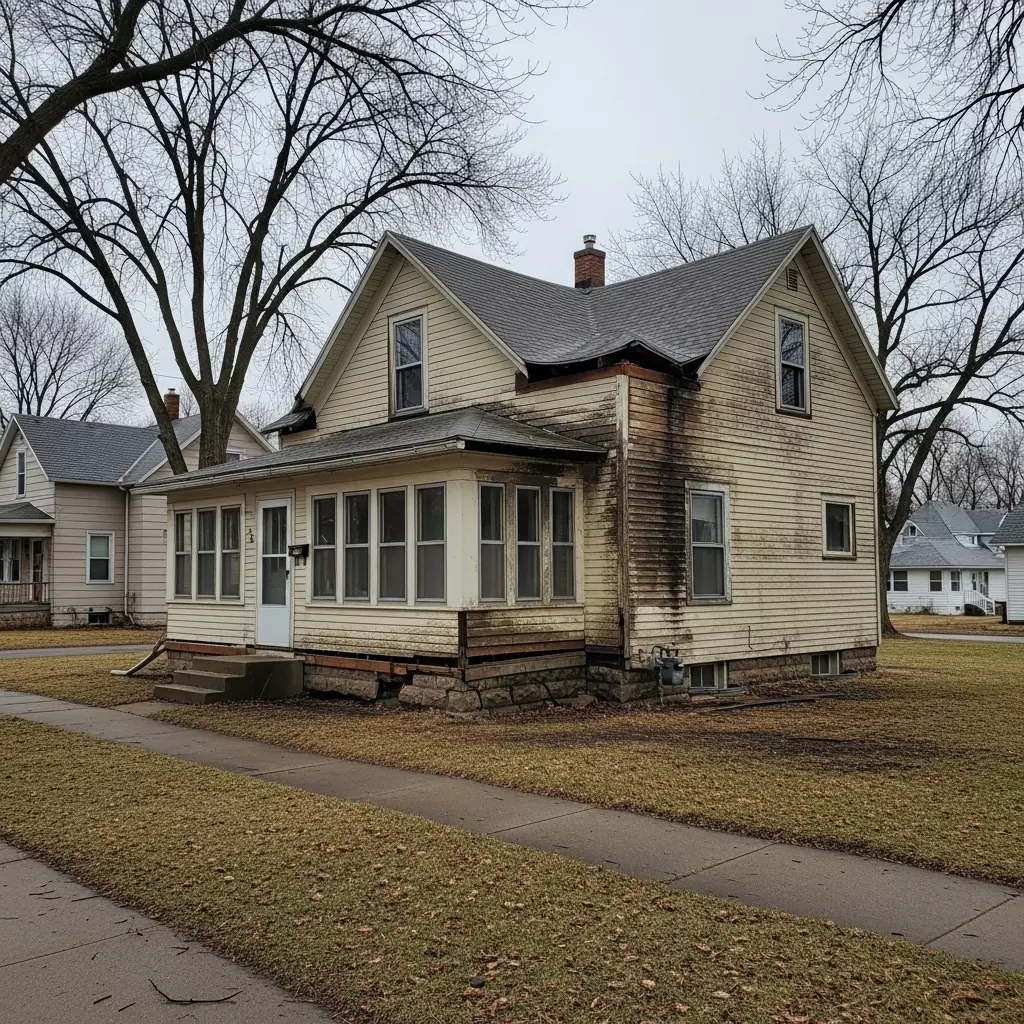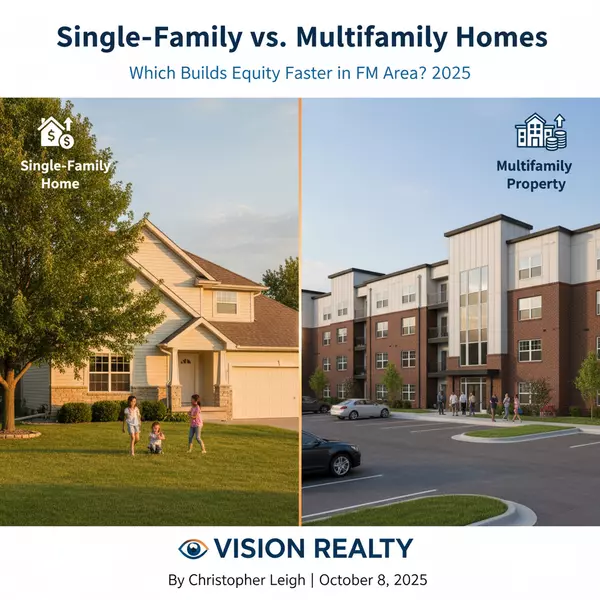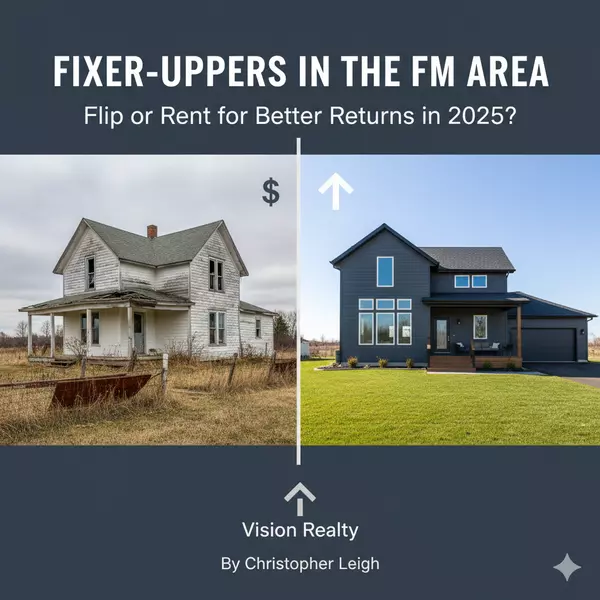Real Estate Investing: 7 Red Flags In a House Flipping Property

Real Estate Investing:
7 Red Flags In a House Flipping Property
In the Fargo/Moorhead area
In the competitive world of house flipping, identifying properties with strong profit potential is only half the equation (see our blog post 7 Green Flags In a House Flipping Property). Equally important is recognizing the warning signs that signal a property, like Christopher’s college girlfriend, might spell t-r-o-u-b-l-e. Even experienced investors can find themselves trapped in money-draining projects when they miss crucial red flags during the acquisition phase.
One of the many benefits of completing several house-flips ourselves, as well as helping many clients through the process, is that we’ve seen some things…uffda have we seen some things…and we can help you find a property that steers clear of the reddest of flags. 🟥
Before committing to your next flip, be vigilant about these seven critical warning signs that should make you reconsider or, at minimum, adjust your offer significantly.
1. Serious Foundation Problems
Foundation issues represent one of the most costly and complicated problems a house flipper can encounter. While minor cracks might be manageable, significant foundation damage can quickly derail your budget and timeline.
Warning signs include:
- Diagonal cracks wider than 1/4 inch in the foundation or walls
- Doors and windows that stick or won't close properly
- Sloping or uneven floors throughout the house
- Separation between walls and ceiling or floors
- Gaps around window frames or exterior doors
- Crumbling or flaking concrete (spalling)
Foundation repairs typically cost between $5,000 and $50,000, depending on the severity. More concerning is that foundation issues often reveal themselves incrementally during renovation, leading to scope creep and blown budgets. Now, depending on the purchase price it might still be worth it, but this is why:
Expert tip: We always have a structural engineer inspect any property with suspected foundation issues before purchasing. Their professional assessment will provide a more accurate repair estimate than a general inspector.
2. Complex Title Issues and Liens
A property with a clouded title can quickly transform from a promising investment into a legal nightmare. Title problems may prevent you from securing financing, obtaining proper permits, or eventually selling the property.
Problematic title issues include:
- Outstanding tax liens or judgments
- Mechanic's liens from unpaid contractors
- Boundary disputes with neighboring properties
- Unclear ownership due to inheritance complications
- Easements that restrict property use or development
- Mortgage foreclosure complications
While title insurance provides some protection, complex title issues can cause significant delays, additional expenses, and in worst-case scenarios, render a property unsellable. One of our flips uncovered a lien against our property from the mortgage of the next door neighbors, who were dead. In the words of a midwesterner, that process was…interesting. Resolution involved lawyers, getting signatures from descendants in several states, and a whole lot of hand-wringing, which is why we suggest:
Expert tip: Always conduct a thorough title search and consider legal consultation if any issues appear, especially with probate or foreclosure properties.
3. Unfavorable Location Factors
“If you build it they will come.” The old adage "location, location, location" holds particularly true in house flipping. A beautifully renovated property in a problematic location will almost always underperform in terms of both days on the market and final purchase price.
Concerning location factors include:
- Proximity to commercial zones, especially heavy industrial areas
- Direct exposure to high-traffic roads or railroads tracks
- Location within the high flood areas of the Red River and the Sheyenne River
- Declining neighborhoods with high vacancy rates
- Limited access to amenities (grocery stores, parks, etc.)
Remember that your target buyers will evaluate not just the house but everything surrounding it. Location problems cannot be renovated away. We’ve seen many properties hit the market, with sellers unwilling to budge on price because it represents their blood, sweat and tears, so the property sits-simply because of the location/property mismatch.
Expert tip: Visit potential properties at different times of day and on different days of the week to uncover location issues that might not be apparent during a single viewing. Drive around the neighborhood. And always check for:
4. History of Water Damage or Flooding
With the Fargo-Moorhead River Flood Diversion project we will see less of these issues inside the diversion moving forward, but there are plenty of other ways to routinely experience water issues on a property. Water damage represents one of the most insidious problems in real estate, often causing structural damage, mold issues, and recurring problems that can be difficult to fully resolve. For example, we know two families dealing with long-term health consequences from living with mold during their renovations, and we take this risk seriously.
Red flags for water issues include:
- Water stains on ceilings, walls, or in basements
- Musty odors indicating possible mold
- Property located in FEMA-designated flood zones
- History of insurance claims for water damage
- Signs of emergency repairs or recent waterproofing
- Dampness or standing water in crawl spaces
- Water marks or damage on basement walls
It might seem like water damage would be obvious to the naked eye, but the signs can be tricky to identify. The Vision Realty Team can help you with our expertly trained eyes, and get you set-up with inspectors who will really drill down into the nitty gritty of water damage potential. Beyond the immediate repair costs, properties with water damage histories may be difficult to insure or may command higher insurance premiums, affecting future buyers' interest.
Expert tip: Request disclosure of any previous flood or water damage claims, and check FEMA flood maps before purchasing. Consider the cost of flood insurance in your investment calculations.
5. Extensive Structural Modifications Without Permits
Unpermitted work, especially structural modifications, can create significant liabilities for house flippers who may be required to bring everything up to code or even return the property to its original configuration.
Signs of problematic unpermitted work:
- Obvious structural changes not reflected in property records
- Recent renovations with no corresponding permits on file
- Amateur-quality modifications to load-bearing walls
- Electrical or plumbing work that clearly violates code
- Additions that don't match the original construction quality
- Suspiciously new work in older homes with no permit history
The cost of remedying unpermitted work often exceeds what it would have cost to complete the work properly with permits initially, as it may involve demolition and reconstruction.
Expert tip: Always check permit history with the local building department before purchasing, and factor in the cost of bringing unpermitted work up to code in your renovation budget.
6. Environmental Hazards
Environmental issues can create health hazards, complicate renovations, and create disclosure obligations when selling the property.
Common environmental red flags include:
- Presence of asbestos in insulation, flooring, or ceiling materials
- Lead paint in homes built before 1978
- Underground oil tanks on the property
- Radon issues commonly found in certain geographic areas
- Evidence of previous meth production (particularly in rural properties)
- Soil contamination from previous industrial use
- Extensive mold infestations requiring professional remediation
Environmental remediation is specialized work that typically requires certified professionals and proper disposal procedures, significantly increasing costs.
Expert tip: For properties built before 1978, always conduct lead paint testing. For properties with suspicious history or in former industrial areas, consider environmental testing as part of your due diligence.
7. Outdated or Insufficient Infrastructure
While outdated fixtures and finishes represent opportunity for house flippers, outdated infrastructure systems can create budget-breaking problems that aren't easily resolved.
Infrastructure concerns include:
- Insufficient electrical service (less than 200 amps in modern homes)
- Knob-and-tube or aluminum wiring that requires complete replacement
- Galvanized or lead water pipes that need full replacement
- Sewer line issues, especially in older neighborhoods
- Outdated HVAC systems that cannot effectively service the home
- Septic system failures or inadequate capacity
- Roof structures that won't support modern roofing materials
These systems form the essential backbone of a property, and upgrading them rarely adds perceived value proportional to their cost, squeezing profit margins.
Expert tip: Budget for complete replacement of any system more than 40 years old, and always scope sewer lines in properties over 25 years old to identify potential issues before purchase.
Conclusion
Successful house flipping requires not just identifying promising opportunities but also recognizing deal-breaking problems. While almost any property can be renovated given unlimited time and resources, profitable flipping depends on accurate assessment of risks and costs.
Remember that the most successful flippers have developed the discipline to say "no" to problematic properties, saving their capital and energy for opportunities with clearer paths to profitability. In house flipping, sometimes the best deals are the ones you don't make. We’d love to sit down with you and sketch out a VISION for your real estate investment, as well as see you through to a successful purchase. Fill out the “Get More Information” form below and schedule a free consultation with The Vision Realty today!
Categories
Recent Posts










GET MORE INFORMATION

